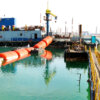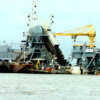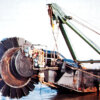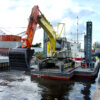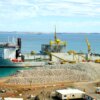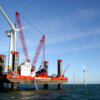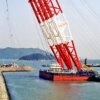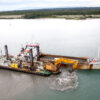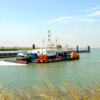A water injection dredger injects large volumes of water into the waterbed, fluidising the sediment so that it can flow naturally to other deeper areas.
Work method of Water injection dredgers
This is a specially developed vessel that uses pumps with a series of nozzles on a horizontal jetbar to spray water at a low pressure into the waterbed. This fluidises the sediment by effectively overcoming the cohesion in fine-grained, cohesive soils or the internal friction of coarse-grained, granular soils.
By fluidising the solid sediment layer into a density current, the material, under certain circumstances will flow out of the port basin. A density current is the fluidised soil layer “on the move”. This fluidised sediment or slurry remains close to the river or channel bed, and through the slope of the seabed and water currents pulled by gravity flows down to deeper areas.
Fluidised soil is also sometimes referred to as fluid mud, fluid bed or density cloud, but since the sediment remains just above the bed, the term “fluidised soil layer” is generally agreed to be a more apt description.
Advantages
Water injection dredging is a cost-effective, environmentally sound solution to some specific dredging operations. With water injection dredging, sediments are not raised from the surface of the water and therefore no disposal takes place. The aim of water injection dredging is to keep sediment out of the water column, moving material horizontally in the lower part of the waterway and restricting it to the vicinity of the seabed.
This process occurs with a minimum of disturbance to the equilibrium of the ecosystem. In this way, instead of mechanical transportation, nature takes care of the sediment transport, making water injection dredging under certain conditions a very cost-efficient dredging technique.
In circumstances in which sediments are not contaminated, and where placement of dredged material back into its own natural environment is permitted, the method can offer environmental advantages and provide cost savings as fewer crew are needed, no auxiliary plant is necessary and less energy is used as the sediment is moved by natural forces.
Types of material
Water injection dredging is most suited for dredging silts, unconsolidated clays and fine sands.
Limitations
The water injection dredger is not effective for dredging fine-grained sediments as cohesion is reduced and consolidation increases. Highly plastic clays cannot be effectively dredged using water injection dredging and it is also not applicable to dredging rock.
Water injection techniques cannot be used where resuspension of sediments is restricted for environmental or other reasons or where contaminants are found in the seabed. They are also less cost-effective for large ports and harbours.
Production rates
The choice of a water injection dredger is site-specific and will depend on soil conditions, hydrodynamic conditions, transport distances and maximum operating depths. The dredging depths of water injection dredgers vary between 26 m to almost 0 m. The working speed is 1 to 2 knots although most water injection dredgers are able to sail faster in non-dredge mode. Portable water injection dredgers can be rapidly deployed to relatively remote sites when necessary.
Project applications
Water injection dredgers are most often used in smaller ports for maintenance dredging. Maintenance dredging involves moving variable quantities of material, ranging from thin to thicker layers, but the sediments to be dredged are usually the most recent top layers which have settled in the navigation channels and harbours.
Because a water injection dredger is manoeuvrable and because it does not dig into or excavate sediment as do traditional dredgers, but rather applies water through jets to dilute the sediment layer, it can operate in places that other types of equipment cannot reach, for instance, underneath jetties and moored vessels. Its low draught also reduces the risk of damaging underwater infrastructure, such as cables and pipelines, quay walls, lock aprons and dry-docks.






